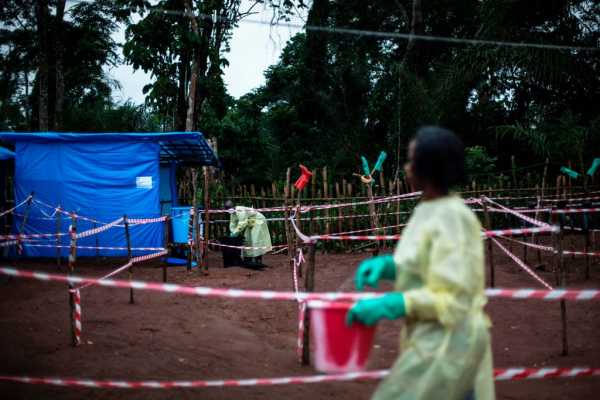
More than 4,000 doses of an Ebola vaccine just arrived in the Democratic Republic of the Congo, where an outbreak of the deadly virus is ongoing.
Merck’s rVSV-ZEBOV is the first highly effective Ebola vaccine, and it’s expected to be an extremely useful tool in the DRC outbreak, which so far involves 41 reported cases and 19 deaths.
“This is the first time it’ll be used in a new outbreak,” said John-Arne Røttingen, chief executive of the Research Council of Norway, who worked on the Ebola vaccine trials. “[Health officials] will vaccinate early on and hopefully before the epidemic takes off.”
This marks a rare public health success story involving a neglected disease, and it’s worth celebrating.
The global community pours more money into fighting baldness and erectile dysfunction than developing treatments or vaccines for “neglected tropical diseases” like Ebola that infect more than a billion of the world’s poorest people. And when these scourges attract funding, it tends to come from defense budgets (remember, Ebola is considered a potential bioterrorism weapon).
So it’s not all that surprising that while it’s been more than 40 years since Ebola’s discovery in 1976, a vaccine to stop the virus from spreading remained elusive — until very recently.
The 2013-’16 West Africa Ebola epidemic caused more than 11,000 deaths — but also sparked a funding surge focused on preventing the disease. The tragedy got the public and private sector galvanized around pushing an Ebola vaccine candidate through the clinical trials process.
As early as this week, the world will begin to see the results of that effort. Every previous Ebola outbreak has been snuffed out through a tried-and-true strategy called “contact tracing”: isolating those related to the sick before they had a chance to infect anyone else, and thus interrupting the human chain of transmission.
This time, health officials also have a vaccine ready to use early on in an outbreak. (To date, the rVSV-ZEBOV vaccine’s clinical trials only involved people in outbreaks that had already been simmering for some time.) According to WHO spokesperson Tarik Jasarevic, the agency obtained all the necessary approvals and permits to start vaccinating as of last Friday. In the coming days, an additional 4,000 doses of the vaccine will arrive in the DRC.
If the experimental vaccine works to prevent Ebola from spreading, it could mean major outbreaks involving Ebola’s Zaire strain, like the one we saw in West Africa a few years ago, will be a thing of the past.
The Ebola vaccine was 100 percent effective in clinical studies — but it sat on the shelf for more than a decade before finally being tested
There are five species of Ebola, four of which have caused the disease in humans: Zaire, Sudan, Taï Forest, and Bundibugyo. (The fifth, Reston, was discovered in Virginia and has infected only monkeys.) The rVSV-ZEBOV was designed to protect against Zaire, the type of Ebola to most commonly affect humans.
But it doesn’t actually contain deadly Ebola virus — it works by replacing a gene from a harmless livestock virus, vesicular stomatitis, with a gene encoding an Ebola virus surface protein to trick the body’s immune system.
Created by the Public Health Agency of Canada in 2003, the vaccine was shown to be 100 percent effective in monkeys. But because of a lack of pharmaceutical company interest before the West Africa outbreak, it literally sat on a shelf until it was licensed to Merck in 2014.
During the West Africa outbreak, researchers — from the World Health Organization, Guinea’s Ministry of Health, Public Health England, and other international partners — worked together to help set up a clinical trial to test the vaccine. In 2015, they published striking preliminary results in the Lancet showing that everyone who got the shot immediately after contact with an Ebola victim didn’t get the virus.
A year later, they unveiled their final results, also in the Lancet, and they were just as amazing. The vaccine was tested in nearly 12,000 people in Guinea and Sierra Leone. Among the 5,837 people who got the vaccine, no Ebola cases were recorded. By comparison, there were 23 cases in the control group that had not gotten the vaccine.
”This trial, confirming the 100 percent efficacy of the rVSV Ebola vaccine, is a simply remarkable outcome,” Dr. Jeremy Farrar, the director of the Wellcome Trust, said when the results came out. “We’ve shown that by working collaboratively, across international borders and sectors, we can develop and test vaccines rapidly and use them to help bring epidemics to an end.”
The surge of interest in Ebola helped spur the development of a new organization called CEPI, the Coalition for Epidemic Preparedness Innovations. Funded by nearly half a billion dollars from the UK’s Wellcome Trust, the Bill & Melinda Gates Foundation, and the governments of Germany, Japan, and Norway, the organization focuses on readying vaccines for the next likely pandemic.
CEPI has been working with Merck to push the Ebola vaccine through clinical trials, though it’s still not yet commercially available. In 2016, the public-private vaccine partnership GAVI paid Merck to stockpile doses of the vaccine, and helped fund Merck’s regulatory effort.
To date, health officials have never been able to deploy the vaccine quickly enough at the start of an outbreak. Just last year, an outbreak of Ebola in the DRC ended before the vaccine needed to be given out.
The deployment of the vaccine could make this outbreak historic
This year is different. At the request of the DRC’s government, the vaccine is about to have its first early field test at the outbreak’s epicenter in Bikoro, in the country’s northwest Équateur province.
Bikoro is in a very remote area of a country that has poor road infrastructure, but it’s situated on a lake connecting the highly trafficked Congo and Ubangi rivers. People infected with Ebola there hop boats to major cities like the DRC’s capital Kinshasa or nearby Brazzaville — a potential public health nightmare officials are trying to prevent quickly.
Last year, the DRC government already approved a clinical trial protocol for the vaccine, according to Jon Cohen at Science magazine. Because the vaccine is still considered experimental, it will be given out to volunteers on the grounds of “compassionate use.”
Doctors Without Borders, the WHO, GAVI, with the DRC’s health ministry in the lead, will collaborate on the vaccine program (including keeping the shots stored at cold temperatures — minus 76 to minus 112 Fahrenheit — that protect its effectiveness).
“This is not a simple logistical effort,” Peter Salama, who leads WHO’s Health Emergencies Program, said in a press briefing last week. “It’s not like doing a polio campaign with oral polio vaccines where we get it immediately out to the field. This is a highly complex, sophisticated operation in one of the most difficult terrains on earth.”
One of the most fascinating things about the vaccine, beyond its apparent safety and effectiveness, is how it’ll be used. Health officials will employ something called “ring vaccination,” an approach used to eradicate smallpox in the 1970s. It involves immunizing the contacts — friends, family, housemates, neighbors — of a person who falls ill with a virus to create a protective ring around them to stop transmission. In the DRC, health workers and other Ebola responders will also be vaccinated.
As soon as a new Ebola case is diagnosed, health workers will trace the person’s contacts and then vaccinate them to prevent anyone else from falling ill. Those people will be followed up for 84 days, the WHO says, to see whether Ebola or any side effects develop.
“[Having the vaccine] doesn’t mean we don’t need to do all those other measures that are standard to an Ebola response,” said the WHO’s Jasarevic. “Having treatment centers, active case finding, contact tracing, having safe and dignified burials, having lab capacity.”
So the vaccine is an exciting new technology — a potentially life-saving one — but its success will hinge on decades-old public health strategies.
Sourse: vox.com






